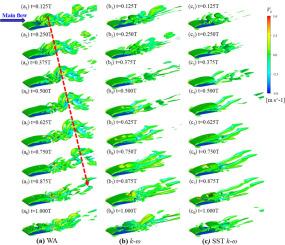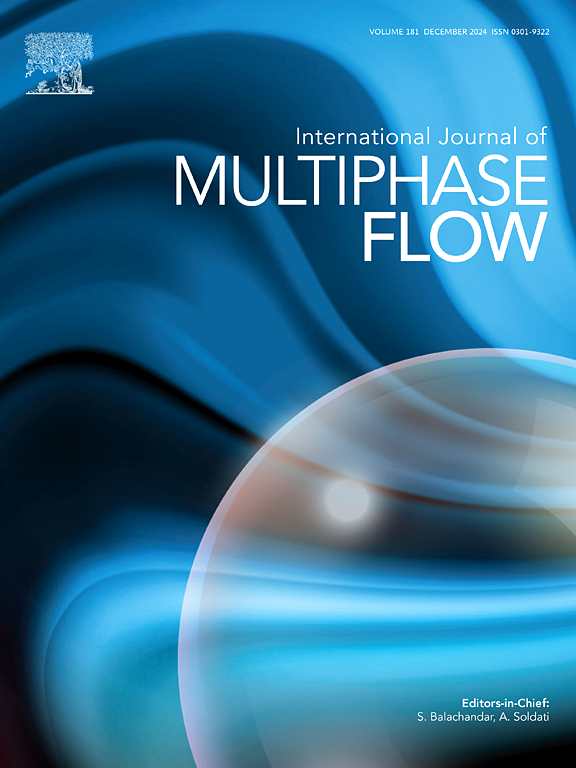Wray-Agarwal湍流模型在三维水翼周围非定常空化数值模拟中的应用
IF 3.8
2区 工程技术
Q1 MECHANICS
International Journal of Multiphase Flow
Pub Date : 2025-08-05
DOI:10.1016/j.ijmultiphaseflow.2025.105395
引用次数: 0
摘要
本文研究了Wray-Agarwal (WA)单方程湍流模型模拟多相流的性能,特别关注三维Clark-Y型水翼周围的云空化。采用非定常reynolds - average Navier-Stokes (RANS)方程,对三种不同湍流模型(wa、k-ω和剪切应力输运(SST) k-ω)的数值模拟结果与实验结果进行了比较。对比突出了水动力行为、空化周期以及空化与涡结构之间的相互作用等关键方面。与k-ω和SST k-ω模型相比,WA模型的误差范围更小,能够有效地预测空化的周期性。通过q准则和涡量输运方程分析涡量的变化,发现涡量的变化受空腔形状和动力学的强烈影响,其中涡旋拉伸和体积膨胀/收缩在观测到的波动中起重要作用。再入射流与主流的相互作用是引发片状空化脱落的关键因素,导致云状空化的形成。这些发现强调了WA模型在准确模拟空化流动方面的有效性,并加深了对空化机制的理解。本文章由计算机程序翻译,如有差异,请以英文原文为准。

Application of the Wray-Agarwal turbulence model in the numerical simulation of unsteady cavitation around a three-dimensional hydrofoil
This research investigates the performance of the Wray-Agarwal (WA) one-equation turbulence model for simulating multiphase flows, particularly focusing on cloud cavitation around a three-dimensional Clark-Y hydrofoil. Using unsteady Reynolds-Averaged Navier-Stokes (RANS) equations, numerical simulations with three different turbulence models—WA, k-ω, and Shear Stress Transport (SST) k-ω—are compared to experimental results. The comparison highlights key aspects such as hydrodynamic behavior, cavitation periodicity, and the interactions between cavitation and vortex structures. The WA model consistently demonstrates improved alignment with experimental data, showing smaller error margins than both k-ω and SST k-ω models, and effectively predicting the cyclical nature of cavitation. Analysis of vortex behavior through the Q-criterion and vorticity transport equation reveals that changes in vorticity are strongly influenced by the shape and dynamics of the cavity, with vortex stretching and volumetric expansion/contraction playing significant roles in the observed fluctuations. The interaction between the re-entrant jet and main flow is identified as the critical factor initiating sheet cavitation shedding, leading to the formation of cloud cavitation. These findings underscore the WA model’s effectiveness in accurately modeling cavitating flows and deepen the understanding of cavitation mechanisms.
求助全文
通过发布文献求助,成功后即可免费获取论文全文。
去求助
来源期刊
CiteScore
7.30
自引率
10.50%
发文量
244
审稿时长
4 months
期刊介绍:
The International Journal of Multiphase Flow publishes analytical, numerical and experimental articles of lasting interest. The scope of the journal includes all aspects of mass, momentum and energy exchange phenomena among different phases such as occur in disperse flows, gas–liquid and liquid–liquid flows, flows in porous media, boiling, granular flows and others.
The journal publishes full papers, brief communications and conference announcements.

 求助内容:
求助内容: 应助结果提醒方式:
应助结果提醒方式:


